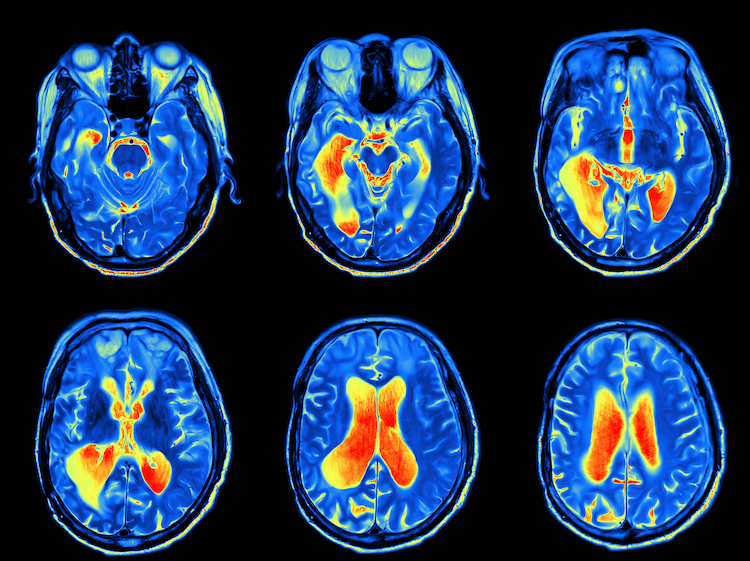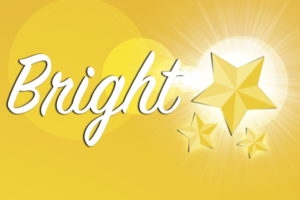by Brock Eide and Fernette Eide
Did you know? Artificial intelligence is now far smarter than humans across many metrics, including testing on Raven’s Progressive Matrices. Join subscribers from RAND, Pearson (Wechsler), Tesla, Microsoft, and Google AI for Dr Alan’s monthly updates on integrated AI:
Get The Memo.
This article is being archived here, after disappearing from the internet around 2017. Please note that the Johns Hopkins archived version incorrectly uses the word “multinodality”, however “multimodality” is the correct word (thanks to Drs Brock and Fernette for the clarification!)
Functional brain magnetic resonance imaging (fMRI) brings exciting new insights into our understanding of how gifted thinkers think. The first thing you notice when you look at the fMRIs of gifted groups is that it looks like a ‘brain on fire.’ Bright red blazes of high metabolic activity burst out all over the scan. Each red patch represents millions of microcombustion events in which glucose is metabolized to provide fuel for the working brain. Gifted brains are remarkably intense and diffuse metabolizers. But the amazing insights do not stop there. The orchestration of activity is planned and complex, and it seems to require the coordination of diverse visual, spatial, verbal, and sensory areas of brain. Gifted thinkers are rarely one-mode thinkers. Rather, they are great organizers of diverse and multimodal information. For teachers and parents of young gifted thinkers, we begin to understand why certain young gifted thinker go awry, and why organization should be an essential aspect of gifted education.
There is the abundant available evidence that gifted children show enhanced sensory activation and awareness. Gifted brains are essentially “hyper-sensitive,” and can be rendered even more so through training. Not only are the initial impressions especially strong, but also the later recollections are often unusually intense or vivid. Because vivid initial impressions correlate with better recollection, gifted brains are also characterized by increased memory efficiency and capacity. These memories are not only especially intense and enduring memories, but they are also frequently characterized by multimodality, involving memory areas that store many different types of memories, such as personal associations, different sensory modalities like color, sound, smell, or visual images, or verbal or factual impressions. This multimodality means that gifted thinkers often make connections in ways other people don’t. They frequently have special abilities in associational thinking (including analogy and metaphor) and in analytical or organizational skills (through which diverse associations are understood and systematized).
As a result of these special brain characteristics, gifted thinkers typically enjoy benefits including more vivid sensing, prodigious memory, greater fund of knowledge, more frequent and varied associations, and greater analytic ability. However, these same neurological characteristics carry a number of potential drawbacks, including sensory, emotional, and memory overload, sensory hypersensitivities, personal disorganization, sensory distractibility, delayed processing due to “analysis paralysis” (or getting “lost in thought” due to an excess of options), and mental fatigue.
One of the keys to maintaining this appropriate balance lies within the front of the brain of gifted thinkers. This balance can be achieved through a coordinated interaction of the right and left lobes in what we’ve termed “Creative Corporate Thinking.” Creative Corporate Thinking consists of a partnership between the Chief Executive Officer (CEO) on the left, and the Creativity Director on the right. The interaction between these two entities is that “corporate balancing act” between the “Suit” or CEO on the left that focuses and prioritizes goals, works out details, and implements strategies, and the “Talent” or Creativity Director on the right that dreams, combines ideas, sensations, and images, generates alternative approaches, and is oriented toward the “Big Picture.” Each of these functions has its distinct “corporate culture” with its unique style and language, and each is essential for good corporate function. The key to optimal thinking is to maintain productive communication and cooperation between the two sides. This cooperation is essential regardless of the task. Even seemingly “analytical” skills like math involve tremendous amounts of imaginative, dreamy, associational thinking; and even seemingly “abstract and creative” skills like painting or sculpting involve tremendous amounts of detailed planning.
There are a number of implications of these findings about gifted brains for teaching gifted children. First, because of their enhanced sensitivity, gifted children tend to learn with fewer repetitions, and to need less extensive explanations in class, although it is important to remember that their sensitivity may be modality specific (that is, hearing, seeing, kinesthetic) rather than across the board. Enhanced sensitivity also frequently results in enhanced distractibility, and gifted children may at times be suspected because of this to have ADHD. However, it is important to remember that in gifted children, distractibility is frequently accompanied by considerable persistence, and even though their attention seems often to wander, so long as it keeps returning to the task at hand and the work gets done, it should not be considered an impediment. In fact, there is considerable evidence that such “distractibility” is one of the roots of creativity. Enhanced sensitivity that results in impaired learning, however, whether because of distractibility to visual, auditory, tactile, or other sensory cues, is a real problem that requires evaluation and treatment.
Second, because of their enhanced memory, gifted children require less review and come to class with more outside knowledge than other children. Frequently they acquire knowledge through “incidental learning”–that is, snatches of overheard, glimpsed, or observed information that are taken in outside of their formal education. Because of their combination of enhanced sensitivity and memory, these kids are like “cognitive flypaper” in that they grab and hold onto ideas and information much more avidly than their peers. Too often this facility for acquiring information has been interpreted as a sign that gifted education should consist of “filling up their brains” with vast quantities of information. However, the exact opposite is true. Because gifted students are able with significantly less effort to acquire the standard knowledge base, information acquisition should actually be given less space in the curriculum rather than more. Rather than simply acquiring more facts, these students should use their extra time learning how to think like experts. They are already information wealthy–they do not need a greater largesse of facts. What they need is to learn what to do with what they already have.
Finally, we believe that a greater proportion of gifted education be allocated toward learning how to organize and process information. Gifted children have a critical need to: understand the nature of their thinking, understand the quality of their information, and understand the uses of information.
By “understanding the nature of thinking” we mean the sort of metacognitive training (or “thinking about thinking”) that would allow gifted thinkers more effectively to direct and manage their own thinking. This training would equip them to understand the nature of memory, sensory processing, mental organization and learning styles, and would arm them with knowledge of mnemonic, organizational, interpersonal, and other problem solving strategies. This training would enable them to approach specific problems and learning in general with the greatest possible chance of success. Gifted students need more time for rumination and reflection, moving back toward a classical model of education in which a few resources were studied in depth and reflected on at length, rather immersed in barrage of information whose depths they are never allowed to explore.
By “understanding the nature of information” we mean equipping students with the ability to evaluate the quality or status of a piece of information as knowledge. With the increasing availability of information in overwhelming amounts from the Internet, it is especially important that students have the ability to independently evaluate the quality and reliability of information. They must be able to ask the right questions of information and be able to evaluate the answers they receive. They must be able to recognize when something is proved or not, what kinds of information count as knowledge and what only as opinions, which sorts of questions can receive final answers, and which only provisional ones. They must be shown how knowledge is acquired and validated in the real world; what the nature of expertise really is in different fields; and how they can play a role in the advance of knowledge. In this way, they will come to realize that knowledge is a dynamic process rather than a static repository of information.
Students need to seek for instrumental or practical uses of information as well as their rational value. In contrast to the abstract, ahistorical way in which subjects like math and science are often taught, children need to learn that society has been advanced by attempts to answer questions that were of practical value to a community, rather than the pursuit of knowledge “for its own sake.”
Finally, we recommend training gifted students in a discipline we called “neuro-rhetoric”– that is, teaching them how to understand the structure and power of arguments, and how it affects what we know. Increasing students’ self-awareness about their own thinking and reasoning processes– and about the nature of information itself– will ideally equip them both to live as productive leaders in our current information age, but will also allow them to take their places as participants rather than mere observers in the ages old process of seeking and advancing knowledge.
References, Further Reading, and How to Cite
About the authors
Brock Eide M.D. M.A. and Fernette Eide M.D.
Brock and Fernette Eide are physicians and consultants to a wide range of parent, teacher, and clinical groups seeking more information about learning and brain-based solutions. Together they have authored more than 50 articles and they speak internationally for keynote lectures, seminars, and small groups. The Eides have a free Neurolearning Newsletter and can be contacted through their website at: www.neurolearning.com or by email at: feide@u.washington.edu or drseide@neurolearning.com.
© Brock and Fernette Eide. December 2004.
Get The Memo
by Dr Alan D. Thompson · Be inside the lightning-fast AI revolution.Informs research at Apple, Google, Microsoft · Bestseller in 147 countries.
Artificial intelligence that matters, as it happens, in plain English.
Get The Memo.
 Alan D. Thompson is a world expert in artificial intelligence, advising everyone from Apple to the US Government on integrated AI. Throughout Mensa International’s history, both Isaac Asimov and Alan held leadership roles, each exploring the frontier between human and artificial minds. His landmark analysis of post-2020 AI—from his widely-cited Models Table to his regular intelligence briefing The Memo—has shaped how governments and Fortune 500s approach artificial intelligence. With popular tools like the Declaration on AI Consciousness, and the ASI checklist, Alan continues to illuminate humanity’s AI evolution. Technical highlights.
Alan D. Thompson is a world expert in artificial intelligence, advising everyone from Apple to the US Government on integrated AI. Throughout Mensa International’s history, both Isaac Asimov and Alan held leadership roles, each exploring the frontier between human and artificial minds. His landmark analysis of post-2020 AI—from his widely-cited Models Table to his regular intelligence briefing The Memo—has shaped how governments and Fortune 500s approach artificial intelligence. With popular tools like the Declaration on AI Consciousness, and the ASI checklist, Alan continues to illuminate humanity’s AI evolution. Technical highlights.This page last updated: 27/Dec/2022. https://lifearchitect.ai/brains-on-fire-the-multimodality-of-gifted-thinkers/↑



